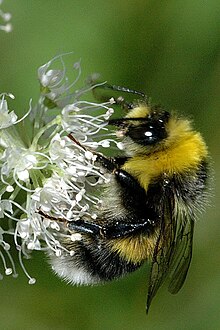Light yellow bumblebee
| Light yellow bumblebee | ||||||||||||
|---|---|---|---|---|---|---|---|---|---|---|---|---|

Light yellow bumblebee |
||||||||||||
| Systematics | ||||||||||||
|
||||||||||||
| Scientific name | ||||||||||||
| Bombus lucorum | ||||||||||||
| ( Linnaeus , 1761) |
The light yellow earth bumblebee or light earth bumblebee ( Bombus lucorum ) is a bumblebee that lives near the ground and is widespread in Germany in open, little-shaded places. It has its ecological importance above all as a pollinating insect of many plants, many of which depend on the bumblebees as pollinators .
Occurrence
The pale yellow bumblebee flies from March to October and is common across Europe. Due to its thick hair, it can also endure relatively low temperatures; so it often comes at high altitudes such as B. the Alps . There, as in the lower areas, it usually occurs in open terrain.
Identifying features
The light yellow bumblebee grows to 9 to 21 mm in size and has twelve-link antennae and large mandibles . Your pinpoint eyes ( ocelles ) are almost in a straight line. The head shield ( clypeus ) and the face are always colored black. The front of the front body ( thorax ) and the second tergite are hairy lemon-yellow or yellowish-white. The rest of the body is otherwise hairy black. The fourth and sixth tergite are usually orange-gray to brown in color. The hairless, shiny rear rails are flat on the outside and provided with a collecting device (the basket) and a heel handle. The thick hair of the abdomen ( abdomen ) hides the tergites, of which only six are visible on the underside. The light earth bumblebee is also pointed at the end. Overall, the bright bumblebee is colored similarly to the dark bumblebee , which is why the species are extremely difficult to distinguish in the field.
ecology
The light yellow bumblebee is a state-building insect. It trains workers, males and queens. The workers are smaller than the males and queens. The queens start building nests and brood in spring. In contrast to some other bumblebees, this takes place in the herb and moss layer. It can therefore be counted among the bumblebees living on the ground. The brood cells , wax cells , cocoons and other storage containers are arranged irregularly. This characteristic distinguishes them from honey bees , which create the cells of their burrow very regularly. The eggs are deposited in special nectar lumps , which mostly consist of plant pollen, in specially created wax cells, in which the first up to 500 individual workers develop. These hatch in spring and take over the further care of the brood and the establishment of the actual state. Only in the summer months do males and females (the actual sex animals) develop and then mate.
literature
- Heiko Bellmann : bees, wasps, ants . 3rd edition, Kosmos , Stuttgart 2017, ISBN 978-3-440-14667-5 .
- Margret Binot-Hafke (Red.): Red list of endangered animals, plants and fungi in Germany. Volume 3, Invertebrates. Part 1 . Federal Agency for Nature Conservation , Bonn-Bad Godesberg 2011, ISBN 978-3-7843-5231-2 .
- Michael Chinery: Parey's Book of Insects. Over 2000 insects in Europe. 2nd edition, Kosmos , Stuttgart 2012, ISBN 978-3-440-13289-0
- Jiří Zahradník: bees, wasps, ants. The hymenoptera of Central Europe . Translated from the Czech by Jürgen Ostmeyer. Franckh , Stuttgart 1985, ISBN 3-440-05445-4 .
Web links
- Video: Bombus lucorum (Apidae) - storing and pulping pollen . Institute for Scientific Film (IWF) 1993, made available by the Technical Information Library (TIB), doi : 10.3203 / IWF / E-3161 .
